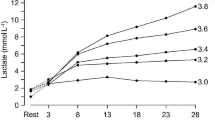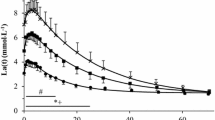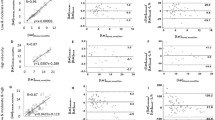Abstract
Based on a mathematical model of the blood circulatory system, we construct a mathematical model for lactate metabolism in a human body. We pose the identification problem for lactate metabolism parameters by measurements. We develop the method, algorithm, and software for solving this identification problem. We also consider practical applications in sports medicine and the training process, in particular in our studies of the anaerobic threshold phenomenon and propose new methods for estimating the individual anaerobic threshold and maximal oxygen consumption for athletes.
Similar content being viewed by others
References
Shumakov, V.I., Novosel’tsev, V.N., Shtengol’d, E.Sh., and Sakharov, M.P., Modelirovanie fiziologicheskikh sistem organizma (Modeling Physiological Systems of the Human Body), Moscow: Meditsina, 1971.
Myakinchenko, E.B. and Seluyanov, V.N., Razvitie lokal’noi myshechnoi vynoslivosti v tsiklicheskikh vidakh sporta (Developing Local Muscular Endurance in Cyclical Sports), Moscow: TVT Divizion, 2009.
Janssen, P., Lactate Threshold Training, Champaign: Human Kinetics, 2001.
Proshin, A.P. and Solodyannikov, Yu.V., Identification of the Parameters of Blood Circulation System, Autom. Remote Control, 2010, vol. 71, no. 8, pp. 1629–1648.
Ostapenko, T.I., Proshin, A.P., and Solodyannikov, Yu.V., Research on Blood Circulation System Identifiability, Autom. Remote Control, 2007, vol. 68, no. 7, pp. 1239–1255.
Proshin, A.P. and Solodyannikov, Yu.V., Mathematical Modeling of Blood Circulation System and Its Practical Application, Autom. Remote Control, 2006, vol. 67, no. 2, pp. 329–341.
Solodyannikov, Yu.V., Elementy matematicheskogo modelirovaniya i identifikatsiya sistemy krovoobrashcheniya (Topics in Mathematical Modeling and Identification of the Blood Circulatory System), Samara: Samar. Univ., 1994.
Geoffrey, B.W., James, H.B., and Brian, J.E., A General Model for the Origin of Allometric Scaling Laws in Biology, Science, 1997, no. 276, pp. 122–126.
Kompleks apparatno-programmnyi neinvazivnogo issledovaniya tsentral’noi gemodinamiki metodom ob”emnoi kompressionnoi ostsillometrii “KAP TsG osm-Globus.” Instruktsiya po primeneniyu (A Hardware-Software Facility for Non-Invasive Studies of Central Hemodynamics with Volume Compression Oscillometry), Belgorod: OOO “Globus,” 2004.
Severinghaus, J.W., Simple, Accurate Equations for Human Blood O2 Dissociation Computations, J. Appl. Physiol., 1979, no. 46, pp. 599–602.
Ellis, R.K., Determination of PO2 from Saturation, J. Appl. Physiol., 1989, no. 67, p. 902.
Rastrigin, L.A., Adaptatsiya slozhnykh sistem (Adaptation in Complex Systems), Riga: Zinatne, 1981.
Proshin, A.P. and Solodyannikov, Yu.V., Modelirovanie i identifikatsiya sistemy krovoobrashcheniya (Modeling and Identification of the Blood Circulatory System), Byull. Izobret., no. 2005611059, 2005.
Wasserman, K.Y. and McIlroy, M.B., Detecting the Threshold of Anaerobic Metabolism in Cardiac Patient during Exercise, Am. J. Cardiol., 1964, no. 14(3), pp. 844–852.
Holtmann, W.F., Zur Frange der Dauerleistungsfahigkeit, Fortschr. Med., 1961, no. 7(4), pp. 443–453.
Conconi, F., Ferrari, M., Ziglio, P.G., et al., Determination of the Anaerobic Threshold by a Non-Invasive Field Test in Runners, J. Appl. Physiol., 1982, no. 52(4), pp. 869–873.
Solov’ev, V.B., Gengin, M.T., Skudnov, V.M., and Petrushova, O.P., Acid-Base Blood Parameters for Sportsmen of Various Qualification Groups in the Norm and under Physical Exercise, Ros. Fiziol. Zhurn. im. I.M. Sechenova, 2010, vol. 96, no. 5, pp. 539–544.
Seluyanov, V.N., Sarsaniya, S.K., Stukalov, B.A., and Slutskii, L.V., Controlling Physical Preparedness in Sporting Adaptology, Teor. Praktika Fiz. Kul’tury, 2008, no. 5, pp. 36–38; 55–56.
Author information
Authors and Affiliations
Additional information
Original Russian Text © A.P. Proshin, Yu.V. Solodyannikov, 2013, published in Avtomatika i Telemekhanika, 2013, No. 6, pp. 133–152.
Rights and permissions
About this article
Cite this article
Proshin, A.P., Solodyannikov, Y.V. Mathematical modeling of lactate metabolism with applications to sports. Autom Remote Control 74, 1004–1019 (2013). https://doi.org/10.1134/S0005117913060106
Received:
Published:
Issue Date:
DOI: https://doi.org/10.1134/S0005117913060106




